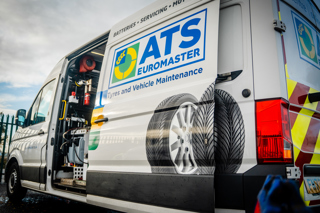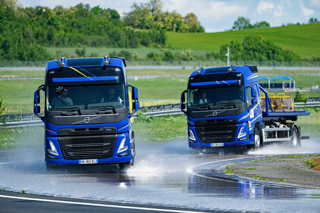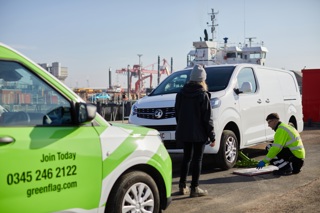Truck operators who want to cut their carbon footprints can find themselves in a quandary.
Battery-electric technology may not offer them range they need, while hydrogen fuel cells may be unsuitable if only because of the lack of availability of environmentally-friendly green hydrogen. Both options are, of course, eye-wateringly expensive.
ZF is offering another choice which, while not zero-emission, can help them mitigate their impact on the environment and offer them breathing space until some of the current drawbacks of batteries and fuel cells have been ironed out. Go hybrid.
The components giant has been busy developing a hybrid variant of its TraXon 2 automated heavy truck transmission which it says will be on sale during the second half of this decade.
Nor will TraXon 2 Hybrid be a one-size-fits-all solution, promises Professor Dr Peter Laier, a member of ZF’s board of management and in charge of the company’s commercial vehicle division.
“We’ll be making it available as everything from a mild hybrid to a plug-in," he says. It all depends on what individual customers require.
Creating such a bridge matters, says ZF, because the number of fully-electric commercial vehicles is growing more slowly than expected in both Europe and the USA. It describes demand as "stagnating”.
That is despite the fact that regulatory pressure on vehicle manufacturers and operators to cut emissions remains unrelenting.
While it is by no means the ultimate solution, TraXon 2 Hybrid can help them meet the targets they have to achieve.
“We need to have transitional technologies,” says Laier.
It is not ZF’s first attempt to add hybrid technology to trucks. Last year it showcased a semi-trailer equipped with its AxTrax 2 electric axle plus a battery in a package which allows energy which would otherwise be lost to be recouped whenever the tractor/trailer combination brakes.
The energy saved can then be used to help propel the vehicle, with fuel and CO2 savings of up to 16% posited.
Opt for the plug-in variant and you can achieve savings of up to 40%, ZF contends. If the tractor unit is electric, then its range will be extended.
Trailer makers Krone and Kassbohrer are involved with the project. The axle system is capable of delivering up to 210kW of continuous power and up to 26,000Nm of torque.
Safety improvements
TraXon 2 Hybrid is but one of a large number of new products and services recently announced by the company addressing areas such as safety as well as emission reduction.
In doing so it is often attempting to develop technology it has already introduced in cars – including hybrid technologies – and make it suitable for trucks.
The strategy appears to be working. Its commercial vehicle division grew by 20% in 2023, outperforming a market that grew by 15%.
“One of our greatest strengths is our flexibility and it’s an approach that is continuing to pay off,” says Dr Holger Klein, chief executive officer at ZF Group.
“We’re the pace-setters for innovation and a one-stop-shop for many of our customers.”
ZF has developed a system for heavy commercial vehicles – and for artics in particular – that uses visual and audible alarms to warn the driver of a truck that is about to change lanes that there is a vehicle in the blind spot and a collision looks likely.
Up to 12% of all accidents on German motorways could be prevented if operators specified it, the company contends.
If there is no danger, then the system allows the truck to change lanes automatically.
All the driver needs to do is look directly at the screen which shows the image delivered by the relevant rear-view camera mirror, indicate, and the truck will move over by itself.
Around 50% of the components used, including the camera and the radar, are passenger car derived and as a consequence have already been tested extensively.
Another example of this approach is the way in which its cubiX motion control software already deployed in cars is now being deployed in trucks.
It integrates all the different driver assistance systems that have been fitted into one centralised platform and ensures they are fully co-ordinated with the brakes, driveline and steering.
The platform manages all the actuators and ZF believes it should make it easier to manage the automated movements of trucks in locations such as ports.
That is because it can translate instructions from virtual driving systems into commands which tell vehicles where they should be going.
It has been tested in conjunction with Germany’s SAFE20 project, which involves driverless tugs shunting semi-trailers around transport yards.
A development which could aid van safety is the way in which SightLine, Goodyear’s intelligent tyre technology, has been integrated into the cubiX ecosystem.
If the vehicle is in danger of aquaplaning in severe wet weather, then the risk will be detected, and optimum speeds recommended to reduce the danger.
If the driver takes no action and the danger rises then cubiX will take steps to stabilise the van and cut its velocity.
The writer sampled this development (admittedly in a car) at ZF’s Jeversen test track, about an hour’s drive from Hanover, Germany, and can confirm that it works effectively. It should be available in vehicles from 2026 onwards.
European GSR2
The European Union is busy implementing GSR2 – General Safety Regulation 2 – which involves the compulsory installation of a variety of new safety devices on vehicles.
It became mandatory for all new trucks seeking EU Type Approval in July 2022 and for all new trucks registered in the EU since July 2024.
It had yet to come fully into force in the UK at the time of writing, but the majority of new trucks sold here are likely to comply.
ZF is, of course, well aware of GSR2, and is now working on packages that will not only meet but exceed its requirements.
On show at Jeversen was a prototype rear- and side-mounted safety camera system for semi-trailers linked to the tractor unit using a data cable. Trailers will figure more highly in GSR2’s next iteration.
GSR2 makes it obligatory to fit a MOIS – Moving Off Information System – which warns the driver if somebody is walking directly in front of the truck.
ZF’s package goes further, automatically applying the brakes if the driver fails to react.
It does the same if the driver is turning left (in a UK context) and fails to respond to a Blind Spot Information System alert that a vulnerable road user (a cyclist for example) is coming up on the vehicle’s nearside.
When the brakes are applied the seatbelts automatically tighten, pinning you to your seat. ZF’s LIFETEC operation is busy developing seatbelt technology, with belt vibration and tightening being used as a means of alerting drivers to hazards which might otherwise be ignored.
Some of the products ZF has to offer only deliver modest fuel consumption and CO2 emission improvements.
Every little bit helps however, and their cumulative effect can be significant.
It has for instance come up with it refers to as an Intelligent Air Management solution suitable for diesel trucks – a two-stage air compressor which can be disengaged from the engine so that it does not pump air for the brakes and other pneumatic systems when it is not required.
This makes it up to 58% more fuel-efficient than a conventional compressor, ZF reckons.
Due to appear in vehicles in 2027 is an energy-efficient electric power steering system for trucks which ZF says will save approximately 0.4 litres of fuel per 100km compared with existing steering systems.
It requires less effort from the driver than a conventional hydraulic steering system during low-speed manoeuvring in urban areas, but delivers plenty of response on A-roads and motorways because its behaviour is speed-dependent.
It self-centres says ZF, and automatically compensate for the effects of an adverse camber on the highway.
Tyre and brake emissions
A truck’s exhaust is not the only source of emissions. The regulatory authorities are putting tyres and brakes under closer scrutiny.
In response ZF has come up with a version of the MAXX air disc brake with a filter developed in conjunction with Mann & Hummel which captures any particles the brake generates.
Fitted, too, is a brake rotor which has been specially coated to increase its hardness and thus reduce the likelihood that it will be a source of harmful particles.
While the term is often used to describe what are in reality no more than highly-sophisticated algorithms, AI – Artificial Intelligence – is enabling new technologies to be developed far more quickly than was the case in the past, says ZF.
It has introduced a cloud-based AI-driven service called Annotate which it says allows the sensors being used in the development of semi- and fully-autonomous driving to be tested ten times more quickly than used to be the case, and 80% more cheaply.
AI can certainly help fleet managers automate a lot of their decisions says ZF, and it has developed its SCALAR digital platform to aid them.
It can rapidly measure the relative performance of different vehicles on a fleet says the company, and can work with driverless trucks as well as with their conventionally-driven counterparts.
By John Lewis


















Login to comment
Comments
No comments have been made yet.